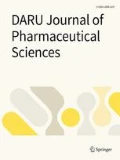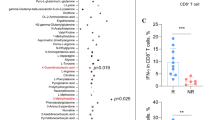Abstract
Purpose
Cobalt-based compounds are emerging as a non-platinum-based anti-cancer effective therapeutic agent. However, there is a limited study regarding the therapeutic efficacy of Cobalt-based drugs against Non-Hodgkin’s Lymphoma (NHLs) such as T cell lymphoma. Therefore, in the present study we investigated the anti-tumor role of cobalt(III) complex [Co(ptsm)NH3(o-phen)]·CH3OH on Dalton’s Lymphoma (DL) cells.
Materials and methods
Cytotoxicity of the cobalt complex was estimated by MTT assay. Analysis of mitochondrial membrane potential, cell cycle and Reactive oxygen species (ROS) generation, and Annexin V/PI staining was done by Flow cytometry, while AO/EtBr staining by fluorescence microscopy in cobalt complex treated DL cell. Expression of cell cycle and apoptosis regulatory protein was analyzed by Western blotting. In addition, in vivo study of the cobalt complex was evaluated in well-established DL bearing mice by monitoring physiological parameters and mean survival time.
Results
Our study showed that cobalt complex triggered apoptosis and induced cell cycle arrest in DL cells. Furthermore, this also decreased mitochondrial membrane potential and increased intracellular ROS generation in cancer cells. In addition, changed expression of cell cycle and apoptosis regulatory protein was found with enhanced activity of caspase-3 and 9 in the treated cells. Additionally, administration of cobalt complex showed a significant increase in the survivability of tumor-bearing host, which was accomplished by decreasing physiological parameters.
Conclusion
Taken together, these data revealed anti-tumor potential of cobalt complex against DL cells through cell cycle arrest and mitochondrial-dependent apoptosis. Henceforth, cobalt-based drugs could be a new generation therapeutic drug to treat hematological malignancies.
Graphical abstract










Similar content being viewed by others
Abbreviations
- AO:
-
Acridine orange
- DAPI:
-
4′, 6-diamidino-2-phenylindole
- DL:
-
Dalton’s Lymphoma
- DMSO:
-
Dimethyl sulphoxide
- EtBr:
-
Ethidium Bromide
- FACS:
-
Fluorescence-activated cell sorting
- H2DCF-DA:
-
2′, 7′-Dichlorofluorescin diacetate
- HT-29:
-
Human colon cancer
- IC50 :
-
Concentration for 50% growth inhibition
- MMP:
-
Mitochondrial Membrane Potential
- MTT:
-
3-(4, 5-dimethylthiazol-2-yl)-2, 5-diphenyltetrazolium bromide
- NHL:
-
Non-Hodgkin Lymphoma
- NAC:
-
N-acetyl cysteine
- PARP:
-
Poly ADP ribose polymerase
- PBS:
-
Phosphate buffered saline
- RPMI:
-
Roswell Park Memorial Institute
- U-87:
-
Glioblastoma cells
References
Koiri RK, Mehrotra A, Trigun SK. Dalton’s lymphoma as a murine model for understanding the progression and development of T-cell lymphoma and its role in drug discovery. International Journal of Immunotherapy and Cancer Research. 2017;3(1):001–6.
Gottesman MM, Fojo T, Bates SE. Multidrug resistance in cancer: role of ATP–dependent transporters. Nat Rev Cancer. 2002;2(1):48–58.
Ndagi U, Mhlongo N, Soliman ME. Metal complexes in cancer therapy–an update from drug design perspective. Drug Design, Development and Therapy. 2017;11:599.
Dasari S, Tchounwou PB. Cisplatin in cancer therapy: molecular mechanisms of action. Eur J Pharmacol. 2014;740:364–78.
Jakupec MA, Galanski M, Arion VB, Hartinger CG, Keppler BK. Antitumour metal compounds: more than theme and variations. Dalton Trans. 2008;2:183–94.
Bratsos I, Jedner S, Gianferrara T, Alessio E. Ruthenium anticancer compounds: challenges and expectations. CHIMIA International Journal for Chemistry. 2007;61(11):692–7.
Lu QB, Zhang QR, Ou N, Wang CR, Warrington J. In vitro and in vivo studies of non-platinum-based halogenated compounds as potent antitumor agents for natural targeted chemotherapy of cancers. E Bio Medicine. 2015;2(6):544–53.
Munteanu CR, Suntharalingam K. Advances in cobalt complexes as anticancer agents. Dalton Trans. 2015;44(31):13796–808.
Gowdhami B, Manojkumar Y, Vimala RT, Ramya V, Karthiyayini B, Kadalmani B, Akbarsha MA. Cytotoxic cobalt (III) Schiff base complexes: in vitro anti-proliferative, oxidative stress and gene expression studies in human breast and lung cancer cells. BioMetals. 2021:1–9.
Law BY, Qu YQ, Mok SW, Liu H, Zeng W, Han Y, Gordillo-Martinez F, Chan WK, Wong KM, Wong VK. New perspectives of cobalt tris (bipyridine) system: anti-cancer effect and its collateral sensitivity towards multidrug-resistant (MDR) cancers. Oncotarget. 2017;8(33):55003.
Ott I, Kircher B, Gust R. Investigations on the effects of cobalt-alkyne complexes on leukemia and lymphoma cells: cytotoxicity and cellular uptake. J Inorg Biochem. 2004;98(3):485–9.
Hopff SM, Onambele LA, Brandenburg M, Berkessel A, Prokop A. Discovery of a cobalt (III) salen complex that induces apoptosis in Burkitt like lymphoma and leukemia cells, overcoming multidrug resistance in vitro. Bioorg Chem. 2020;104:104193.
Ghandhi LH. Cobalt picolinamide complexes as potential anti-cancer agents. Doctoral dissertation, University of Leeds, 2017.
Nath P, Bharty MK, Dani RK, Tomar MS, Acharya A. Mn (II), co (III), Ni (II), cd (II) and cu (II) complexes of 2-Thenoyltrifluoroacetone: syntheses, structures, photoluminescence, thermal, electrochemical and antitumor studies on Dalton's lymphoma cells. Chemistry Select. 2017;13(32):10449–58.
Gharbavi M, Johari B, Eslami SS, Mousazadeh N, Sharafi A. Cholesterol-conjugated bovine serum albumin nanoparticles as a tamoxifen tumor-targeted delivery system. Cell Biol Int. 2020;44(12):2485–98.
Rastogi RP, Singh SP, Häder DP, Sinha RP. Detection of reactive oxygen species (ROS) by the oxidant-sensing probe 2′, 7′-dichlorodihydrofluorescein diacetate in the cyanobacterium Anabaena variabilis PCC 7937. Biochem Biophys Res Commun. 2010;397(3):603–7.
Singh RK, Verma PK, Kumar S, Shukla A, Kumar N, Kumar S, Acharya A. Evidence that PKCα inhibition in Dalton's lymphoma cells augments cell cycle arrest and mitochondrial-dependent apoptosis. Leuk Res. 2022;106772.
Gharbavi M, Johari B, Rismani E, Mousazadeh N, Taromchi AH, Sharafi A. NANOG decoy oligodeoxynucleotide–encapsulated niosomes nanocarriers: a promising approach to suppress the metastatic properties of U87 human glioblastoma multiforme cells. ACS Chem Neurosci. 2020;11(24):4499–515.
Verma PK, Gond MK, Bharty MK, Acharya A. Mitochondrial pathway mediated apoptosis and cell cycle arrest triggered by cobalt (III) complex in Dalton’s lymphoma cells. Journal of Applied Pharmaceutical Science. 2021;11(10):007–15.
Liu LH, Shi RJ, Chen ZC. Paeonol exerts anti-tumor activity against colorectal cancer cells by inducing G0/G1 phase arrest and cell apoptosis via inhibiting the Wnt/β-catenin signaling pathway. Int J Mol Med. 2020;46(2):675–84.
Singh RK, Verma PK, Kumar A, Kumar S, Acharya A. Achyranthes aspera L leaf extract induced anticancer effects on Dalton's Lymphoma via regulation of PKCα signaling pathway and mitochondrial apoptosis. Journal of Ethnopharmacology. 2021;274:114060.
Akindele AJ, Wani ZA, Sharma S, Mahajan G, Satti NK, Adeyemi OO, Mondhe DM, Saxena AK. In vitro and in vivo anticancer activity of root extracts of Sansevieria liberica Gerome and Labroy (Agavaceae). Evid Based Complement Alternat Med. 2015;2015.
Baracca A, Sgarbi G, Solaini G, Lenaz G. Rhodamine 123 as a probe of mitochondrial membrane potential: evaluation of proton flux through F0 during ATP synthesis. Biochimica et Biophysica Acta (BBA)-Bioenergetics. 2003;1606(1–3):137–46.
Yi M, Parthiban P, Hwang J, Zhang X, Jeong H, Park DH, Kim DK. Effect of a bispidinone analog on mitochondria-mediated apoptosis in HeLa cells. Int J Oncol. 2014;44(1):327–35.
Minard-Colin V, Brugières L, Reiter A, Cairo MS, Gross TG, Woessmann W, Burkhardt B, Sandlund JT, Williams D, Pillon M, Horibe K. Non-Hodgkin lymphoma in children and adolescents: progress through effective collaboration, current knowledge, and challenges ahead. J Clin Oncol. 2015;33(27):2963.
Armitage JO, Gascoyne RD, Lunning MA, Cavalli F. Non-hodgkin lymphoma. Lancet. 2017;390(10091):298–310.
Thamilarasan V, Sengottuvelan N, Sudha A, Srinivasan P, Chakkaravarthi G. Cobalt (III) complexes as potential anticancer agents: physicochemical, structural, cytotoxic activity and DNA/protein interactions. J Photochem Photobiol B Biol. 2016;162:558–69.
Al-Naeeb AB, Ajithkumar T, Behan S, Hodson DJ. Non-Hodgkin lymphoma. BMJ. 2018;362.
Diumenjo MC, Abriata G, Forman D, Sierra MS. The burden of non-Hodgkin lymphoma in central and South America. Cancer Epidemiol. 2016;44:S168–77.
Alghamdi NJ, Balaraman L, Emhoff KA, Salem AM, Wei R, Zhou A, Boyd WC. Cobalt (II) diphenylazodioxide complexes induce apoptosis in SK-HEP-1 cells. ACS Omega. 2019;4(11):14503–10.
Lee SH, Meng XW, Flatten KS, Loegering DA, Kaufmann SH. Phosphatidylserine exposure during apoptosis reflects bidirectional trafficking between plasma membrane and cytoplasm. Cell Death & Differentiation. 2013;20(1):64–76.
Perillo B, Di Donato M, Pezone A, Di Zazzo E, Giovannelli P, Galasso G, Castoria G, Migliaccio A. ROS in cancer therapy: the bright side of the moon. Exp Mol Med. 2020;52(2):192–203.
Li L, Wong YS, Chen T, Fan C, Zheng W. Ruthenium complexes containing bis-benzimidazole derivatives as a new class of apoptosis inducers. Dalton Trans. 2012;41(4):1138–41.
Chipuk JE, Green DR. How do BCL-2 proteins induce mitochondrial outer membrane permeabilization? Trends Cell Biol. 2008;18(4):157–64.
Aggarwal V, Tuli HS, Varol A, Thakral F, Yerer MB, Sak K, Varol M, Jain A, Khan M, Sethi G. Role of reactive oxygen species in cancer progression: molecular mechanisms and recent advancements. Biomolecules. 2019;9(11):735.
Samanta A, Ravindran G, Sarkar A. Quinacrine causes apoptosis in human cancer cell lines through caspase-mediated pathway and regulation of small-GTPase. J Biosci. 2020;45(1):1–8.
González-Gironès DM, Moncunill-Massaguer C, Iglesias-Serret D, Cosialls AM, Pérez-Perarnau A, Palmeri CM, Rubio-Patiño C, Villunger A, Pons G, Gil J. AICAR induces Bax/Bak-dependent apoptosis through upregulation of the BH3-only proteins Bim and Noxa in mouse embryonic fibroblasts. Apoptosis. 2013;18(8):1008–16.
Li X, Qiu Z, Jin Q, Chen G, Guo M. Cell cycle arrest and apoptosis in HT-29 cells induced by dichloromethane fraction from Toddalia asiatica (L.) Lam. Frontiers in Pharmacology. 2018;9:629.
Meikrantz W, Schlegel R. Apoptosis and the cell cycle. J Cell Biochem. 1995;58(2):160–74.
Hermeking H, Lengauer C, Polyak K, He TC, Zhang L, Thiagalingam S, Kinzler KW, Vogelstein B. 14-3-3σ is a p53-regulated inhibitor of G2/M progression. Mol Cell. 1997;1(1):3–11.
Acknowledgments
Authors are thankful to Dr. Manoj Kumar Bharty, Department of Chemistry, Banaras Hindu University, Varanasi for providing cobalt (III) complex. We also acknowledge Interdisciplinary School of Life Science, Banaras Hindu University, Varanasi for providing Fluorescence microscopy and Flow cytometry facilities. PKV is a recipient of Senior Research Fellowship from the Indian Council of Medical Research (ICMR-SRF/45/73/2018/PHA/BMS), India. The work was supported by the grants received from Banaras Hindu University and DST- SERB (P-07/705), government of India to corresponding author.
Availability of data and materials
Available upon the request.
Author information
Authors and Affiliations
Contributions
The research work presented in the manuscript is a part of Ph.D. thesis of PKV. PKV and AA designed the study. PKV, RKS, SK and AS performed all the experiments. PKV, RKS and AA wrote the manuscript and PKV, RKS, SK and AA critically revised corrected and modified the manuscript. MKG and MKB provided cobalt complex.
Corresponding author
Ethics declarations
Ethics approval
Ethical approval was taken from Institutional Animal Ethics committee of the Department of Zoology, Banaras Hindu University (BHU), Varanasi, India (Reference No. BHU/DoZ/IAEC/ 2018–19/51).
Informed consent
For this type of study formal consent is not required.
Consent for publication
Not applicable.
Competing interests
The Authors declare that there is no conflict of interest among the authors.
Additional information
Publisher’s note
Springer Nature remains neutral with regard to jurisdictional claims in published maps and institutional affiliations.
Rights and permissions
About this article
Cite this article
Verma, P.K., Singh, R.K., Kumar, S. et al. Cobalt (III) complex exerts anti-cancer effects on T cell lymphoma through induction of cell cycle arrest and promotion of apoptosis. DARU J Pharm Sci 30, 127–138 (2022). https://doi.org/10.1007/s40199-022-00439-7
Received:
Accepted:
Published:
Issue Date:
DOI: https://doi.org/10.1007/s40199-022-00439-7




